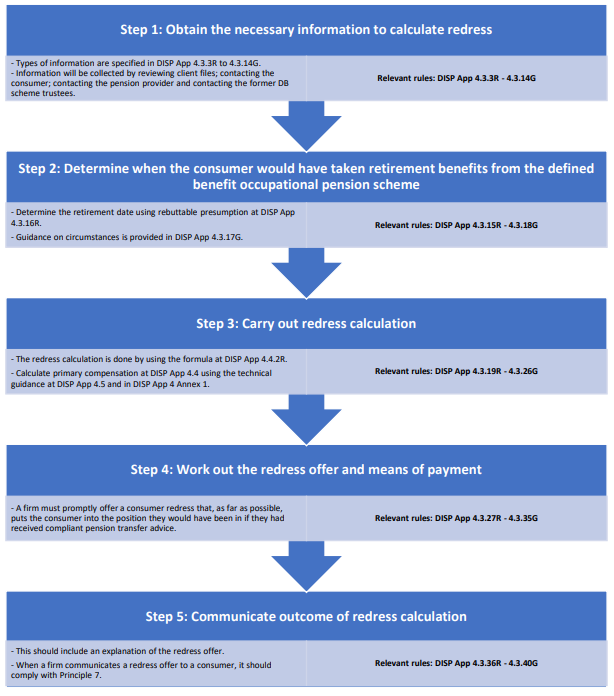DISP App 4.1 Definitions
1The following definitions are used in this appendix:
- (1)
‘additional compensation sum’ is the redress sum calculated in accordance with DISP App 4.3.29R(3);
- (2)
‘annual allowance’ is the maximum amount that can be added to an individual’s pension each tax year without the individual being liable for an annual allowance tax charge;
- (3)
‘annual allowance tax charge’ includes:
- (a)
the standard annual allowance limit of £40,000 saved into a pension in the current tax year; and
- (b)
the money purchase annual allowance which is triggered when a consumer has flexibly accessed their pension, which reduces their annual allowance to £4,000; and
- (c)
the tapered annual allowance which reduces the annual allowance for those earning above £200,000;
- (a)
- (4)
‘assumptions’ are the economic, demographic and other assumptions to be used in the redress calculation set out at DISP App 4 Annex 1;
- (5)
‘augmentation’ is the payment of redress into the consumer’s chosen defined contribution pension scheme;
- (6)
‘calculation date’ is the date on which the firm completes the calculation at Step 3 at DISP App 4.3.19R;
- (7)
‘commencement date’ is 1 April 2023;
- (8)
‘compliant pension transfer advice’ is advice to a consumer on the conversion or transfer of pension benefits from a defined benefit occupational pension scheme to a DC pension arrangement, which complies with the following:
- (a)
(as applicable) the suitability requirements in COBS 9 and COBS 19.1; and
- (b)
the common law duty in contract or tort to exercise reasonable skill and care in advising the consumer; and
- (c)
(where the advice is to remain in the defined benefit occupational pension scheme and the firm arranges the pension transfer or pension conversion) a firm’s obligations when dealing with insistent clients (from 1 January 2018, see COBS 9.5A);
- (a)
- (9)
‘DC pension arrangement’ means any pension arrangement holding the value of the consumer’s pension benefits which originated from the non-compliant pension transfer advice, including where the arrangement has been subsequently changed to a new arrangement;
- (10)
‘defined contribution pension scheme’ means an occupational or non-occupational pension scheme with a right or entitlement to flexible benefits;
- (11)
‘non-compliant pension transfer advice’ is advice to a consumer on the conversion or transfer of pension benefits from a defined benefit occupational pension scheme to a DC pension arrangement, which does not comply with one or more of the following:
- (a)
(as applicable) the suitability requirements in COBS 9 and COBS 19.1;
- (b)
the common law duty in contract or tort to exercise reasonable skill and care in advising a consumer; or
- (c)
(where the advice is to remain in the defined benefit occupational pension scheme and the firm arranges the pension transfer or pension conversion) a firm’s obligations when dealing with insistent clients (from 1 January 2018, see COBS 9.5A);
- (a)
- (12)
‘non-joiner’ is a consumer who declined or failed to join an occupational pension scheme for which they were or are eligible, while continuing in the relevant employment;
- (13)
‘normal retirement age’ is the earliest age at which the consumer could have retired from the defined benefit occupational pension scheme without both their employer’s consent and actuarial reduction;
- (14)
‘payment date’ is the date that the redress is paid to the consumer;
- (15)
‘pension tranche’ is an element of pension benefit which typically has a unique combination of revaluation increases before coming into payment and pension increases during payment, but may also have a unique payment starting age or payment end age;
- (16)
‘primary compensation sum’ is the redress sum calculated in accordance with DISP App 4.3.20R;
- (17)
‘quarter’ is the period of 3 months commencing 1 January, 1 April, 1 July and 1 October in each year;
- (18)
‘redress offer’ is an offer of redress made to a consumer after a firm has determined that the consumer suffered loss as a result of non-compliant pension transfer advice;
- (19)
‘retirement date’ is the consumer’s presumed or alternative retirement date determined in accordance with DISP App 4.3.15R to 4.3.18R;
- (20)
‘secondary compensation sum’ is the redress sum comprising the components in DISP App 4.3.29R(2);
- (21)
‘SERPS’ is the state earnings related pension scheme;
- (22)
‘settlement date’ is the date on which the firm’s redress offer is accepted by the consumer;
- (23)
‘unauthorised payment’ is defined in section 160 of the Finance Act 2004;
- (24)
‘unauthorised payment charges’ include any tax charges levied pursuant to chapter 5, part 4 of the Finance Act 2004; and
- (25)
‘valuation date’ is the date at which the benefits in the defined benefit occupational pension scheme and benefits in the DC pension arrangement must be valued for the calculation at Step 3 at DISP App 4.3.19R.






